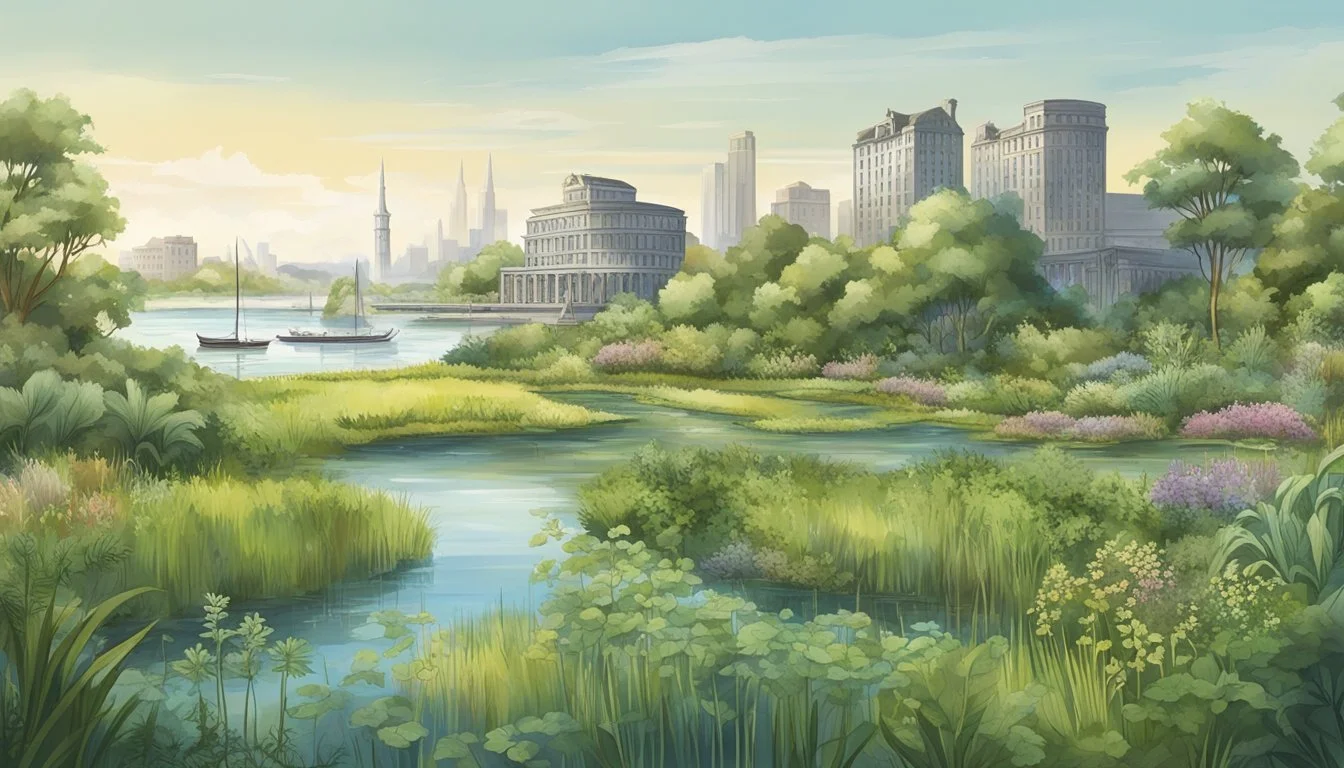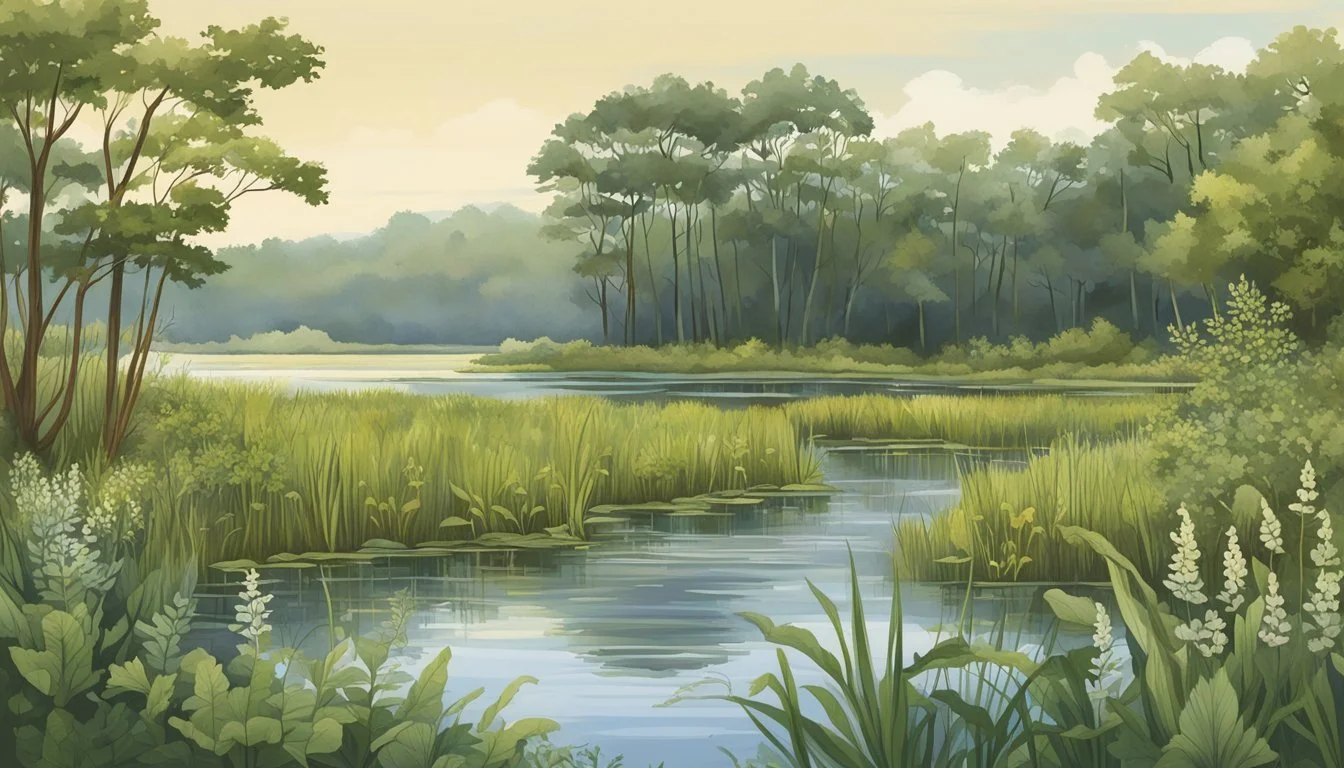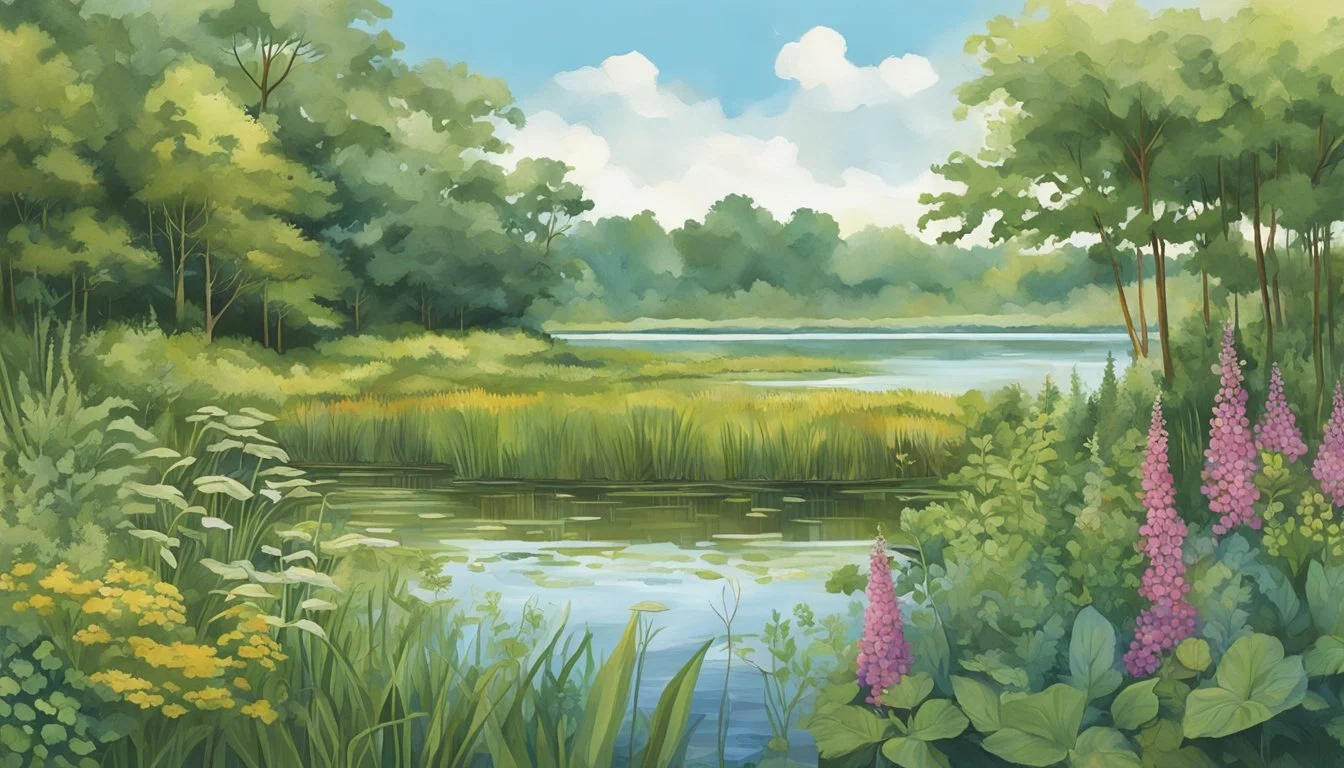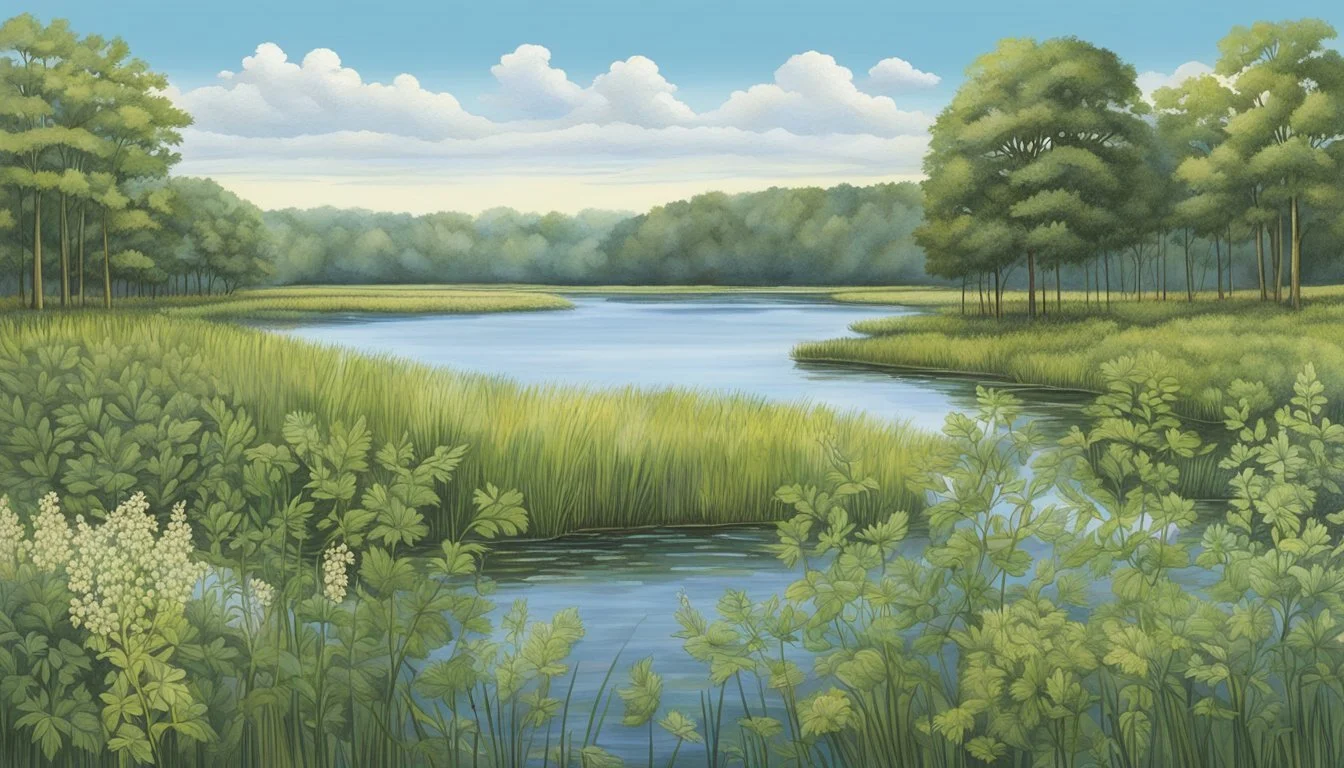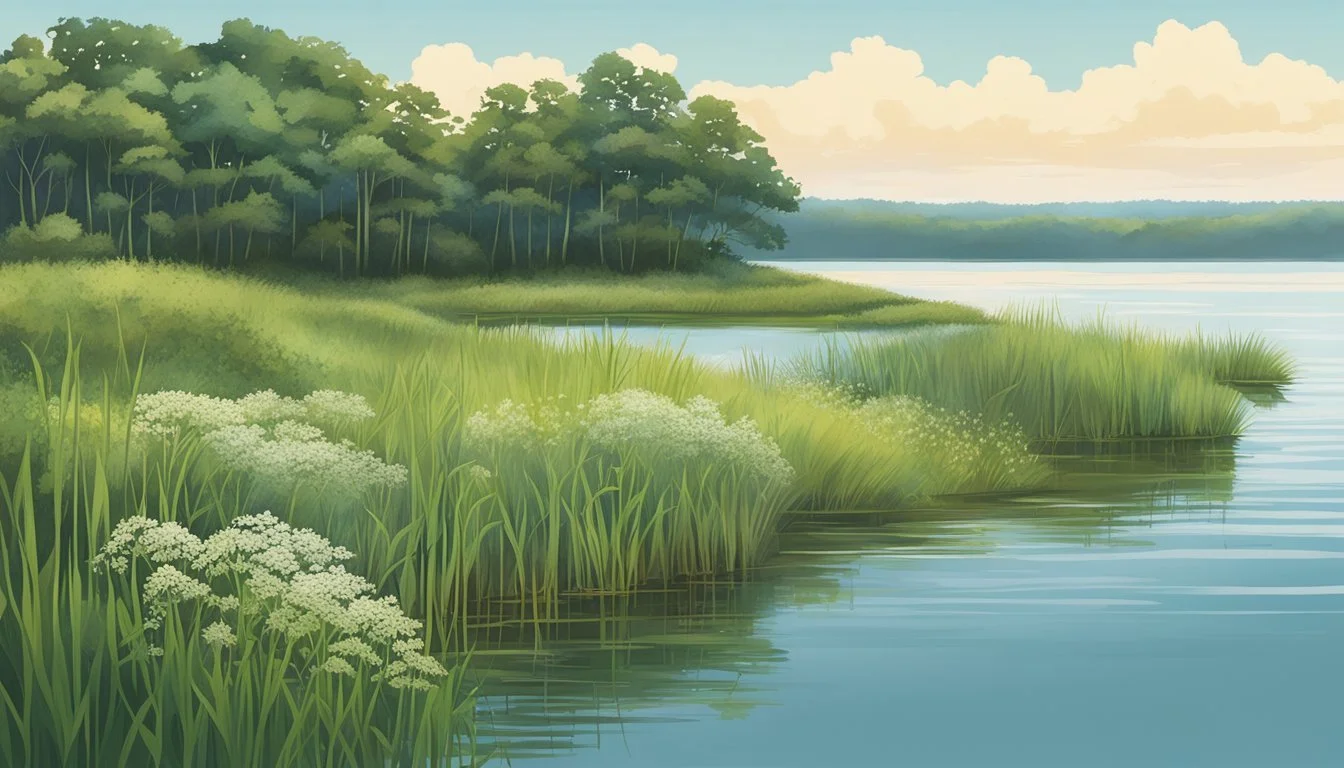Chesapeake Bay Native Edible Plants
A Guide to Local Foraging
Nestled along the East Coast, the Chesapeake Bay is home to a diverse array of native plants that have been used for centuries by Indigenous peoples and later settlers for food, medicine, and other purposes. The region's flora not only supports the ecosystem by filtering polluted runoff and stabilizing soil but also offers a rich variety of edible species that thrive in its unique environment. Understanding which native plants are edible and how they can be used is crucial for anyone interested in foraging, sustainable living, or simply exploring the natural bounty the Bay has to offer.
Among these native plants, the red maple (Acer rubrum) stands out for its versatility. Traditionally used by Indigenous tribes for its medicinal properties, an infusion of the bark was taken for cramps, hives, and dysentery. Another notable mention is wild strawberries (Fragraria virginiana and F. vesca), which ripen from May through July and, despite their smaller size compared to domestic varieties, pack a delicious punch. Both plants exemplify the potential culinary and health benefits that can be discovered in the Chesapeake Bay area.
The Bay's native flora provides not just a food source but also plays a crucial role in supporting the local ecosystem. These plants help protect against the impacts of heat and hurricanes, maintaining the delicate balance needed for the thriving biodiversity of the region. By learning about these native edible plants, one can foster a deeper connection to the environment and contribute to the sustainable use of natural resources.
Historical Significance and Current Importance
Native plants in the Chesapeake Bay watershed hold both historical and contemporary importance due to their integral roles in indigenous cultures and sustainable practices.
Role in Indigenous Cultures
For centuries, various indigenous tribes in the Chesapeake Bay region, such as the Piscataway and the Nanticoke, have utilized native plants for food, medicine, and other purposes. Plants like pawpaw (Asimina triloba) and American persimmon (Diospyros virginiana) have been staples in their diets. Wild rice, harvested using traditional methods, continues to be a crucial food source.
These plants were not only used for sustenance but also played a significant role in cultural rituals and medicinal practices. Indigenous knowledge about these plants has been passed down through generations, ensuring their continued relevance and use in modern times.
Modern Use in Sustainable Practices
Today, the importance of native plants in the Chesapeake Bay extends to environmental conservation and sustainable agriculture. These plants are key in filtering polluted runoff, stabilizing soil, and providing habitat for wildlife. Organizations like the Alliance for the Chesapeake Bay actively promote the use of native species to restore and protect the Bay’s ecosystems.
Additionally, wild rice and other native grains are cultivated both for commercial purposes and environmental benefits. By incorporating native plants into sustainable practices, communities can enhance biodiversity, support local wildlife, and contribute to the long-term health of the Chesapeake Bay watershed.
Ecological Impact
Native edible plants in the Chesapeake Bay area significantly contribute to the health of the watershed and support local wildlife. Their presence ensures the stability and sustainability of the ecosystem by providing essential services such as soil stabilization and habitat formation.
Contribution to the Watershed's Health
Native plants like grasses and perennials play a crucial role in filtering polluted runoff. They absorb excess nutrients and contaminants, which helps to keep the watershed clean.
Their deep root systems enhance soil health by preventing erosion. This helps maintain soil structure and fertility, which is essential for the overall health of the ecosystem.
Furthermore, these plants improve water quality by reducing sedimentation and stabilizing stream banks. This reduces the risk of flood damage and promotes healthier aquatic life. Native plants are specially adapted to local conditions, making them more resilient and requiring less maintenance.
Support of Local Wildlife
Native edible plants provide critical food and cover for various wildlife species. Birds, mammals, and pollinators like bees and butterflies rely on these plants for sustenance and habitat.
For instance, berries and seeds offer nutrition to bird species, while flowering plants attract pollinators. This enhances biodiversity, promoting a balanced ecosystem.
Additionally, native plants form habitats for small mammals, frogs, and turtles, supporting the complex food web. Local wildlife thrives in these native plant communities, which are well-adapted to the environment, unlike their non-native counterparts.
In summary, native edible plants are indispensable for maintaining the ecological balance of the Chesapeake Bay area, benefiting both the watershed and the diverse wildlife it supports.
Botanical Profiles
The Chesapeake Bay area boasts a diverse array of native edible plants. Key species include Pawpaw, Serviceberry, Wild Berries, and Jerusalem Artichoke, each offering unique characteristics and benefits.
Pawpaw (Asimina triloba)
Pawpaw, known scientifically as Asimina triloba, produces the largest edible fruit native to North America. The fruit has a custard-like texture and a flavor often compared to a mix of banana, mango, and melon.
Key Characteristics:
Flora: Deciduous tree.
Habitat: Prefers rich, well-drained soil. Typically found in floodplains and shady forests.
Harvest Time: Late summer to early fall.
Pawpaw trees also provide valuable habitat and food for local wildlife, including various species of birds.
Serviceberry (Amelanchier arborea)
Serviceberry, or Amelanchier arborea, is a small tree or large shrub known for its white spring blossoms and sweet, edible berries. These berries are often used in pies, jams, and as fresh snacks.
Key Characteristics:
Flora: Deciduous tree/shrub.
Habitat: Thrives in moist, well-drained soil, often found in forests and along stream banks.
Harvest Time: Late spring to early summer.
The berries also provide essential nutrition for birds and other wildlife throughout the region.
Wild Berries (Vaccinium sp., Raspberries, Blackberries)
Wild berries in the Chesapeake Bay area include a range of species like Vaccinium (blueberries), raspberries, and blackberries. These fruits are not only delicious but also packed with vitamins and antioxidants.
Key Characteristics:
Flora: Low-growing shrubs or brambles.
Habitat: Usually found in open fields, forests, and along woodland edges.
Harvest Time: Mid-summer to early fall depending on the species.
These berries are crucial food sources for birds, small mammals, and various pollinators.
Jerusalem Artichoke (Helianthus tuberosus)
Jerusalem Artichoke, also known as Helianthus tuberosus, is a sunflower species grown for its edible tuber. The tubers have a nutty flavor and can be eaten raw or cooked.
Key Characteristics:
Flora: Perennial sunflower.
Habitat: Prefers well-drained soil and full sun, often found in fields and along riverbanks.
Harvest Time: Fall through winter.
Jerusalem Artichoke plants are also effective in stabilizing soil and preventing erosion, contributing to the health of the local ecosystem.
Habitats and Cultivation
Understanding the specific habitats and ideal cultivation practices of native edible plants in the Chesapeake Bay area is crucial for successful growing. Specific soil requirements, climate conditions, and available resources play significant roles in plant health and yield.
Growing Conditions in the Chesapeake Bay Area
The Chesapeake Bay area provides diverse habitats that support various native edible plants. Coastal and inland regions exhibit a range of soil types, from sandy coastal soils to loamy, fertile inland soils. Native groundcover, such as blue and green foliage, help maintain soil health and reduce erosion.
Local plants are adapted to the climatic conditions of the region. Hot, humid summers and mild winters create a specific growing environment. Regular rainfall supports lush vegetation but necessitates good drainage to prevent waterlogging. Plants such as blueberries, pawpaw, and wild strawberries thrive under these conditions.
By using plants suited to local conditions, gardeners can minimize the need for artificial inputs like fertilizers and pesticides. This promotes a more sustainable and self-sufficient agricultural practice in the region.
Native Plants for Home Gardens
Home gardeners can create productive spaces using native Chesapeake Bay plants which are ideal for gardens, balconies, and even containers. Choosing the right species is essential. Nursery-sourced plants like serviceberries and hazelnuts are excellent for home landscapes.
When selecting plants, consider their mature size and growth requirements. For instance, hazelnuts need sufficient space for their expansive root systems, while wild strawberries make excellent groundcover in smaller areas.
Soil preparation involves ensuring the pH is suitable and enriching it with organic matter. Routine maintenance includes monitoring for pests, which can be less problematic due to the natural resistance of native species. Overall, native gardens provide ecological benefits and require less intensive upkeep compared to non-native options.
Conservation Efforts
Efforts to conserve native edible plants in the Chesapeake Bay region focus on protecting local flora and combating invasive species threatening the ecosystem's balance. These activities involve various organizations dedicated to preserving the region's biodiversity.
Protecting the Native Flora
Preservation of native plants, such as those in the Chesapeake Bay watershed, is crucial. The Maryland Native Plant Society and the Native Plant Society of Virginia play vital roles.
They promote stewardship practices, encouraging landowners to cultivate native species.
Programs like the National Park Service's conservation initiatives ensure native plants thrive. For example, native grasses and wildflowers with deep root systems reduce erosion and improve soil health.
Educational outreach helps the community understand the importance of maintaining native flora. This includes providing resources for identifying and growing native plants, which are inherently adapted to local climate and soil conditions, thus requiring less maintenance.
Combating Invasive Species
Invasive species pose a significant threat to the Chesapeake Bay's native plant populations. These species can outcompete native flora, leading to biodiversity loss.
Organizations like the Maryland Native Plant Society and local government agencies actively work to remove invasive species.
Initiatives include public awareness campaigns and volunteer programs for manual removal of invasive plants. They emphasize the use of native plants in landscaping to prevent the introduction and spread of non-native species.
Monitoring programs help detect new invasive species early. This allows for timely interventions before they become established and cause irreparable damage to the ecosystem.
Edible and Medicinal Uses
The Chesapeake Bay region is home to a variety of native edible plants that serve both culinary and medicinal purposes. These plants offer unique flavors and nutritional benefits, and many have a rich history of usage by Indigenous peoples.
Wild Edibles for Foraging
In the Chesapeake Bay area, pawpaw trees are a notable source of fruit that is rich in vitamins. The pawpaw fruit is often compared to a mix of banana and mango in flavor.
Wild mint is another valuable edible plant found in the region. It can be used to make tea, providing both flavor and digestive benefits.
The roots of Arrow Arum (Peltandra virginiana) are rich in starch and can be used to make breads and soups once properly cooked.
Other herbaceous plants like wild mustard and dandelion greens serve as vegetables, adding unique tastes and nutritional benefits to foraged meals.
Herbal Remedies and Nutritional Value
Many plants in the Chesapeake Bay area offer medicinal properties. Wild mint is renowned for its soothing effects on the digestive system and can be brewed into tea.
Elderberry flowers and berries provide significant health benefits; they are known for their immune-boosting properties and are rich in vitamins.
The Arrow Arum's root, when thoroughly cooked, provides starch that is nutritious and was traditionally used for making bread and soup, particularly by Indigenous groups.
Herbs like oregano and thyme not only add flavor to dishes but also contain antioxidants and essential nutrients.
These plants have been used historically by Indigenous peoples and continue to offer benefits today, demonstrating their long-standing value.
Wildlife and Pollinator Support
Native edible plants in the Chesapeake Bay play a critical role in supporting local wildlife and pollinators. These plants offer food and shelter to various species, contributing significantly to the ecosystem's health.
Plants Beneficial to Pollinators and Birds
Certain native plants attract pollinators like bees, butterflies, and birds. Perennials such as Milkweed and Bee Balm provide nectar and pollen, vital for pollinators. Milkweed supports Monarch butterflies by serving as a host plant for larvae. Similarly, Wild Bergamot attracts hummingbirds and bees, due to its vibrant flowers and high nectar content.
Plants like Serviceberry and Elderberry yield fruits that feed birds and small mammals. These berries are not only nutritious but help sustain wildlife through different seasons. Additionally, Coneflowers and Black-Eyed Susans offer seeds enjoyed by birds, particularly finches.
Creating Wildlife-Friendly Habitats
Establishing wildlife-friendly habitats involves integrating native plants that cater to the needs of various species. Planting a mix of trees, shrubs, and perennials ensures diverse food sources and safe nesting spots. For example, Oak Trees provide acorns, which are a crucial food source for deer and squirrels, while also offering shelter.
Incorporating dense shrubs like Winterberry and Spicebush offers protection and nesting sites for birds and small mammals. Creating patches of flowering plants such as Goldenrod and Joe-Pye Weed supports pollinators, offering nectar throughout the growing season.
Designing gardens with layered vegetation mimics natural habitats, promoting biodiversity. Moreover, reducing lawn areas in favor of native plant gardens enhances habitat quality and supports ecological balance.
Environmental Challenges
Native edible plants in the Chesapeake Bay face significant environmental issues related to both human activity and climate change. These challenges impact not only the plants themselves but also the wider ecosystem they support.
Impact of Pesticides and Pollutants
Pesticides and pollutants pose a serious threat to native edible plants around Chesapeake Bay. Runoff containing chemical fertilizers and industrial pollutants contaminates soil and water, affecting plant health and growth. Pollutants disrupt nutrient cycles, leading to poor soil quality and weaker plants.
Pesticides used in nearby agricultural activities can drift into natural habitats, killing beneficial insects and harming plant biodiversity. Contaminated water sources reduce the health of wetland plants, impacting their ability to filter pollutants and sustain local wildlife.
Climate Change and Native Plant Adaptation
Climate change significantly affects native plants in the Chesapeake Bay. Rising temperatures and increased heat stress challenge many species' survival and reproductive cycles. Heat can alter blooming times and reduce seed viability, weakening native plant populations.
Additionally, shifts in climate patterns lead to unpredictable weather events, such as hurricanes and droughts, stressing these plants further. Native plants adapted to specific soil and water conditions struggle as these elements become more erratic. Effective conservation requires understanding these changes and supporting the resilience of native plant species.
Culinary and Cultural Significance
The native edible plants of the Chesapeake Bay have been crucial not only for their culinary uses but also for their deep-rooted cultural significance. These plants have shaped local diets for centuries and continue to influence modern culinary practices.
Traditional Chesapeake Bay Cuisine
Many traditional dishes in the Chesapeake Bay area feature native plants as key ingredients. The pawpaw (Asimina triloba) and American persimmon (Diospyros virginiana) are often found in desserts and preserves. Wild berries such as blackberries and blueberries are commonly used in jams and pies.
Shellfish and fish from the Bay frequently incorporate native herbs and vegetables. Sassafras leaves, for example, are used to flavor gumbo. Local tribes like the Piscataway relied on these plants for nutrition and medicine, integrating them deeply into their lifestyle.
Cultural Heritage and Modern Adaptations
The cultural heritage of Chesapeake Bay communities reflects a profound connection to native flora. Indigenous tribes, including the Nanticoke and Powhatans, historically used plants not just for food but also for ceremonial purposes. Arrow arum (Peltandra virginiana) roots were dried and made into breads and soups, showcasing traditional preparation methods.
Today, there's a renewed interest in these plants for sustainable living. Farmers and chefs incorporate them into modern cuisine, highlighting their environmental benefits. Edible flowers have gained popularity for both their ornamental and culinary uses, adding historical significance to contemporary dishes.
Cultural practices in the region continue to evolve, blending ancient traditions with new culinary trends. These native plants remain central to both historical and modern-day Chesapeake Bay life.


